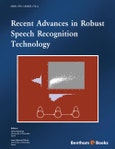This E-book is a collection of articles that describe advances in speech recognition technology. Robustness in speech recognition refers to the need to maintain high speech recognition accuracy even when the quality of the input speech is degraded, or when the acoustical, articulate, or phonetic characteristics of speech in the training and testing environments differ. Obstacles to robust recognition include acoustical degradations produced by additive noise, the effects of linear filtering, nonlinearities in transduction or transmission, as well as impulsive interfering sources, and diminished accuracy caused by changes in articulation produced by the presence of high-intensity noise sources. Although progress over the past decade has been impressive, there are significant obstacles to overcome before speech recognition systems can reach their full potential. Automatic speech recognition (ASR) systems must be robust to all levels, so that they can handle background or channel noise, the occurrence on unfamiliar words, new accents, new users, or unanticipated inputs. They must exhibit more ‘intelligence’ and integrate speech with other modalities, deriving the user’s intent by combining speech with facial expressions, eye movements, gestures, and other input features, and communicating back to the user through multimedia responses. Therefore, as speech recognition technology is transferred from the laboratory to the marketplace, robustness in recognition becomes increasingly significant. This E-book should be useful to computer engineers interested in recent developments in speech recognition technology.
Table of Contents
Foreword iPreface ii
Contributors iii
CHAPTERS
Section I. Voice activity detection
1. Integration of statistical model-based voice activity detection and noise suppression
for noise robust speech recognition 1
Masakiyo Fujimoto
2. Using GARCH Process for Voice Activity Detection 13
Rasool Tahmasbi
3. Voice activity detection using contextual information for robust speech recognition 30
Javier Ramírez and Juan Manuel Górriz
4. Improved Long term Voice Activity Detection for Robust Speech Recognition 46
Juan Manuel Górriz and Javier Ramírez
Section II. Speech enhancement
5. Speech enhancement algorithms: A survey 60
Philipos C. Loizou
6. Speech enhancement and representation employing the independent component
analysis 103
Peter Jancovic, Xin Zou and Munevver Kokuer
7. Statistical Model based Techniques for Robust Speech Communication 114
Nam Soo Kim and Joon-Hyuk Chang
Section III. Speech recognition
8. Bayesian Networks and Discrete Observations for Robust Speech Recognition 133
Antonio Miguel, Alfonso Ortega and Eduardo Lleida
9. Robust Large Vocabulary Continuous Speech Recognition Based on Missing Feature
Techniques
Yujun Wang, Maarten Van Segbroeck and Hugo Van hamme
10. Distribution-Based Feature Compensation for Robust Speech Recognition 155
Berlin Chen and Shih-Hsiang Lin
11. Effective Multiple Regression for Robust Single- and Multichannel Speech
Recognition 169
Weifeng Li, Kazuya Takeda and Fumitada Itakura
12.Higher Order Cepstral Moment Normalization for Improved Robust Speech
Recognition 175
Chang-Wen Hsu and Lin-Shan Lee
13. Reviewing Feature Non-Linear Transformations for Robust Speech Recognition 190
Luz García, José Carlos Segura and Ángel de la Torre
Section IV. Emerging applications
14. Advances in Human-Machine Systems for In-Vehicle Environments: Noise and
Cognitive Stress/Distraction 197
John H.L. Hansen, Pongtep Angkititrakul, and Wooil Kim
Index 211








